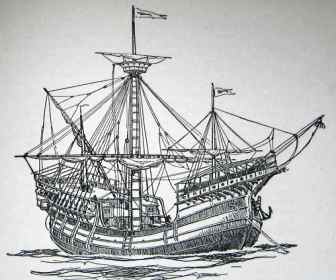More Pirate Pages
Pirate Fun
Carrack Ship Info- The Pirate's Realm

A carrack or nao was a three- or four-masted sailing ship developed in the Mediterranean in the 15th century. It had a high rounded stern with an aftcastle and a forecastle and bowsprit at the stem. It was square-rigged on the foremast and mainmast and lateen-rigged on the mizzenmast.

Carracks were the first proper ocean-going ships in Europe; large enough to be stable in heavy seas, and roomy enough to carry provisions for long voyages. They were the ships in which the Spanish and Portuguese explored the world in the 15th and 16th centuries. In Spanish this type was called carraca or nao, while in Portuguese it was called nau (both of which meant simply "ship"). In French it was nef.
English military carracks were called great ships.
The carrack was the high seas beast of burden of choice and has been described as the "perfected transport ship".-
- it offered the space for crew, provisions and also cargo.
- they were virtually impregnable to attack from small craft, which was often a problem in the East Indies.
- their ability to carry cargo and provisions made them independent of ports en route, and so they had a longer range using the most efficient route.
- the combination of four sails allowed for a fair degree of flexibility - the large square sales provided propulsion, but were reduced in size during storms. The smaller sails at bow and stern allowed for manouvering, and the lateen sails allowed for sailing across the wind.
- the stable deck allowed for placement of guns, thus making the vessel an effective gun platform. This fact would greatly assist the Portuguese in convincing non-compliant rulers like the Samoothiri Raja in Asia.
However, the large superstructures of these ships made them prone to toppling in strong winds.
Wikipedia contributors (2006). Carrack. Wikipedia, The Free Encyclopedia. Retrieved 22:16, May 6, 2006 from http://en.wikipedia.org/w/index.php?title=Carrack&oldid=50253321.
Before the galleon, the Spanish and Portuguese sailed huge carracks on their trade routes. These well-armed three-masted ships were the biggest around and could reach over 1100 tons. A carrack ship could most always fend for itself against pirates.
See also our page about all pirate ships.